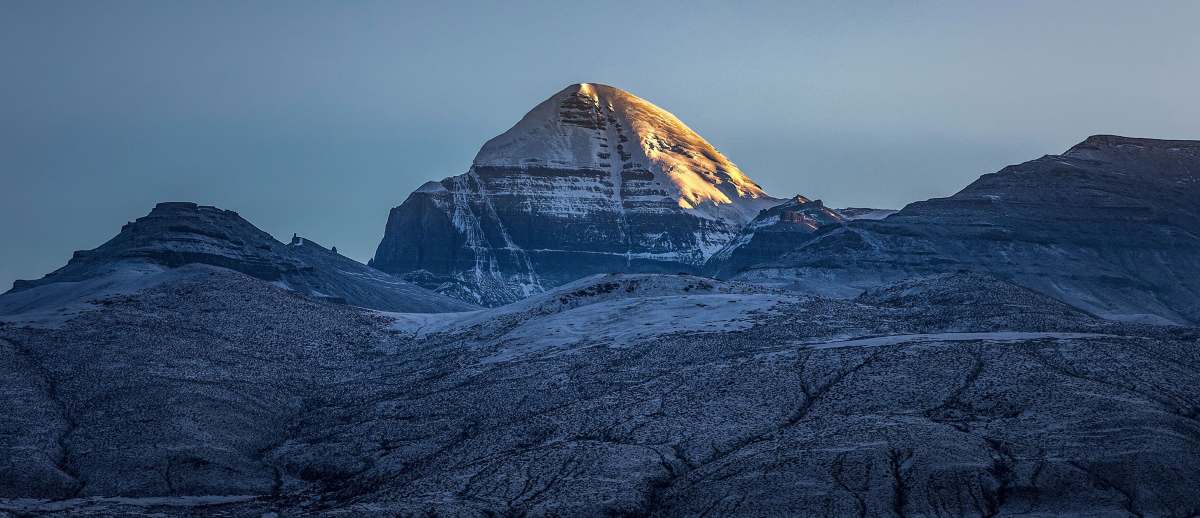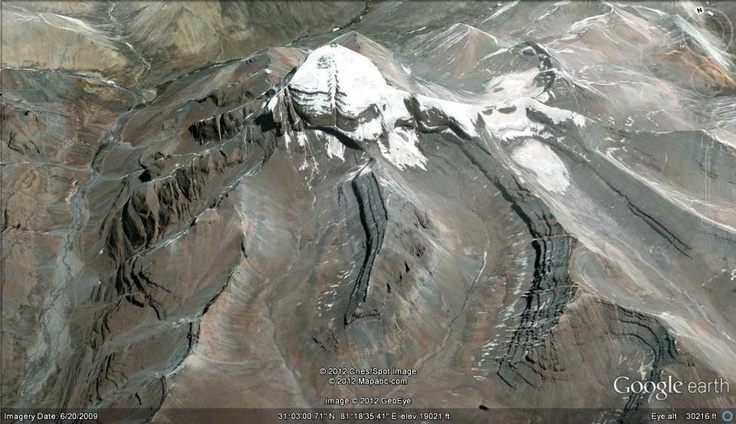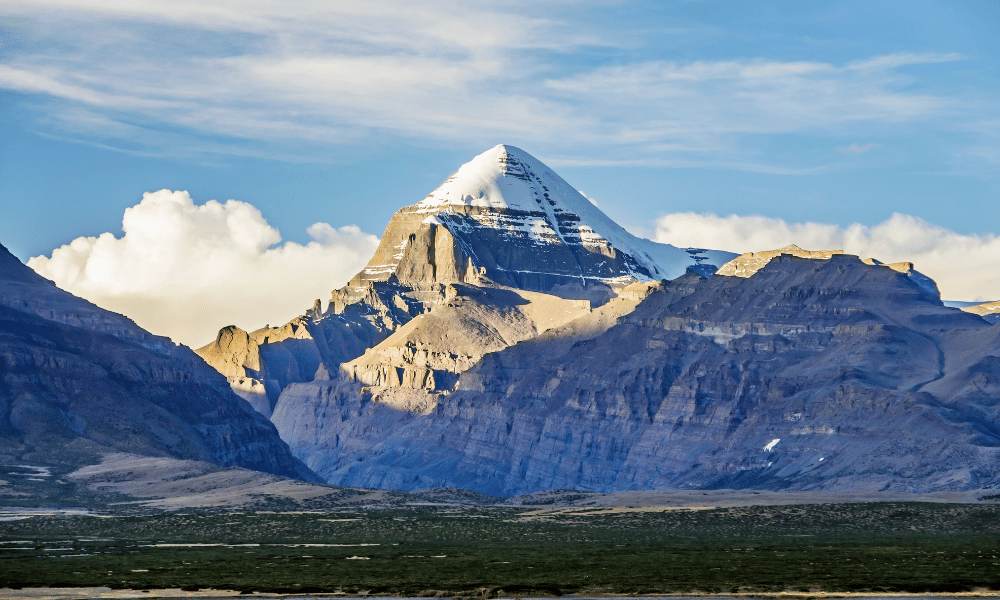Did you know that no one has ever climbed Mount Kailash? Despite being just 6,638 meters (21,778 feet) high, much lower than Everest, the peak remains untouched.
Climbers believe that supernatural forces prevent ascents, whereas scientists believe that its unique shape and extreme weather make climbing nearly impossible.
Mount Kailash, located in Tibet’s remote Kailash Range, is known for its perfect pyramid-like structure. It is the heavenly abode of Lord Shiva, one of the Tridev in Hindu mythology. It is considered a sacred pilgrimage site for Hindus, Buddhists, Jains, and Bonpos.

Source: Kailash Journeys
The mountain is also believed to be the centre of the universe and a place where spiritual energy flows abundantly.
Some researchers even speculate that it could be a massive man-made pyramid. It is also the source of four major rivers—Indus, Sutlej, Brahmaputra, and Karnali—making it a crucial geographical landmark.
In this article, we’ll take a look at the scientific facts behind the sacred peak of Mount Kailash. Why has no one ever climbed it, or why do your nails and hair grow more rapidly than under other normal conditions? Let’s uncover!
Check Out| When is Mahashivratri 2025? Check Date, Significance and Tithi Details
Mount Kailash: Geographic Characteristics
Mount Kailash is a pyramid-shaped mountain in Ngari Prefecture, Tibet, China. It stands in the Kailash Range, part of the Transhimalaya, on the western Tibetan Plateau.
The peak rises to 6,638 meters (21,778 feet), making it one of the most striking mountains in the region. It sits north of the point where China, India, and Nepal meet. Despite its height, no one has ever climbed it, adding to its mystery and sacred status.
- Location: Mount Kailash is located in the Ngari Prefecture of the Tibet Autonomous Region of China, near the western trijunction of China, India, and Nepal.
- Coordinates: The exact coordinates are approximately 31.0675° N latitude and 81.3119° E longitude.
- Elevation: The peak of Mount Kailash stands at an elevation of 6,638 meters (21,778 feet).
- Mountain Range: It is part of the Kailash Range, also known as the Gangdisê Mountains, within the Transhimalaya range.
- Geological Composition: The mountain consists of thick conglomerate rocks sitting on a base of granite.
- Faces of the Mountain: Each face of Mount Kailash is believed to represent different aspects of spirituality. The northern face has steep slopes and rugged cliffs, while the southern face is more accessible. The eastern and western faces are mostly rocky and snow-covered.
- Surrounding Features: It is situated near Manasarovar and Rakshastal lakes and is the source of several major rivers, including the Indus, Sutlej, Brahmaputra, and Karnali.
- Topography: The region features deep valleys, towering peaks, and remote rocky terrain, creating a challenging landscape for travellers.
Why No One Has Ever Climbed Mount Kailash: Myths and Scientific Reasons
Mount Kailash remains one of the world's most revered and unclimbed mountains. Its inaccessibility is attributed to spiritual and scientific reasons.
Here are some of the key myths and scientific explanations for why no one has successfully climbed Mount Kailash:
Spiritual Reasons
- Religious Significance: Mount Kailash is deeply revered in Hinduism, Buddhism, Jainism, and the Bon religions.
- In Hinduism, it is considered the abode of Lord Shiva, the residence of Demchok in Buddhism, and the site of enlightenment for Jainism's first Tirthankara, Rishabhanatha.
- Prohibition by Authorities: The Chinese government officially prohibited climbing due to its sacred status, ensuring the mountain remains untouched.
Scientific and Environmental Reasons
- Physical Challenges: The mountain's pyramid-like shape, steep slopes, and constant snow cover make it incredibly difficult to climb. The slopes are almost vertical, requiring immense physical endurance and mountaineering expertise.
- Harsh Weather Conditions: The region experiences unpredictable and severe weather, including powerful winds and sudden blizzards. These conditions pose significant risks to climbers, making it hard to maintain stability and progress.
- High Altitude: Mount Kailash stands at approximately 6,638 meters (21,778 feet), which exposes climbers to extreme altitude sickness and other health hazards. The thin air at such high altitudes can lead to serious health issues.
- Remote Location: The lack of established climbing routes and rescue infrastructure increases the dangers of a Kailash expedition. The remote location complicates rescue operations and logistical support.
For You| List of Countries in Europe: Interesting Facts, Population, Area
7 Lesser-Known Facts About Mount Kailash That Will Surprise You

Source: Pinterest
Mount Kailash, standing at 6,656 meters in western Tibet, is shrouded in spiritual reverence and scientific intrigue.
While its cultural significance is widely recognised, the mountain’s geological, environmental, and climatic peculiarities offer equally compelling narratives grounded in research. Below are 7 lesser-known scientific facts about this enigmatic peak.
1. Geological Formation and Age
Mount Kailash’s structure comprises thick conglomerate rocks resting on a granite base, shaped by tectonic activity during the collision of the Indian and Eurasian plates.
Geological samples from the region, including magmatic and plutonic rocks, date back 20–25 million years, indicating its formation during the Oligocene-Miocene epochs.
The Kailash flysch zone—a 20-kilometre stretch of peridotites, shales, and dolomites—marks the northern boundary of the Himalayas and highlights the mountain’s role in the region’s tectonic evolution.
2. Pyramidal Structure: Natural or Artificial?
The mountain’s near-perfect pyramidal shape has sparked debates. Russian geologist Dr Ernst Muldashev proposed that Mount Kailash is an ancient, man-made pyramid surrounded by over 100 smaller pyramidal structures, with heights ranging up to 1,800 meters.
However, mainstream geology attributes this symmetry to natural erosional processes acting on horizontally layered sedimentary rocks. Chinese scientists further argue that extreme weather and erosion over millennia sculpted its distinct form.
3. Accelerated Climate Change on the Tibetan Plateau
The Tibetan Plateau, including Mount Kailash, is warming three times faster than the global average, with temperatures rising by 0.3°C per decade.
This rapid warming has led to glacial retreat, permafrost thawing, and altered precipitation patterns, threatening the region’s fragile ecosystems and water resources.
The Kailash Sacred Landscape Conservation Initiative monitors these changes to devise sustainable conservation strategies.
4. Vertical Slopes and Climbing Challenges
Mount Kailash’s near-vertical slopes, coupled with harsh weather (sudden blizzards, temperatures plunging to -20°C), make it technically unclimbable. Despite its moderate height, no summit attempts have succeeded, partly due to the absence of established routes and rescue infrastructure.
5. Glacial History and Water Resource Significance
The region retains remnants of Quaternary-period ice sheets that retreated ~10,000 years ago. Today, Mount Kailash feeds four major Asian rivers—the Indus, Sutlej, Brahmaputra, and Karnali—through glacial meltwater, making it a critical water tower for millions.
6. Sacred Landscape Conservation Efforts
The International Centre for Integrated Mountain Development (ICIMOD) leads the Kailash Sacred Landscape Initiative, focusing on climate resilience, biodiversity conservation, and sustainable tourism in collaboration with China, India, and Nepal.
7. Microclimate and Weather Extremes
The mountain creates a microclimate characterised by arid conditions (100–250 mm annual rainfall) and temperature extremes, ranging from 17°C in summer to -20°C in winter. These conditions contribute to its unique alpine desert-steppe ecosystem.
Additionally, Mt. Kailash is approximately 6,666 kilometres away from the North Pole; however, to your surprise, The distance to the South Pole is exactly twice that of the North Pole, at 13,332 kilometres.
What Are the Unique Geological Features of Mount Kailash?
Mount Kailash is distinguished by several unique geological features that contribute to its mystique and scientific interest. Here are some of the key geological characteristics:
Unique Geological Features
- Pyramidal Shape: Mount Kailash is renowned for its symmetrical pyramidal shape, which is unusual in the region. This shape is attributed to erosion during the Quaternary ice ages, which carved out valleys and slopes, creating its distinctive form.
- Black Rock Composition: Unlike surrounding peaks composed of sedimentary rock, Mount Kailash is made of black rock, a rare occurrence in the region. This composition adds to its geological distinctiveness.
- Conglomerate and Granite Base: The mountain consists of thick conglomerate rocks resting on a granite base, part of the Gangdese batholith. These granitic rocks formed between 100 million and 45 million years ago as a result of magmatic activity during the India-Asia collision.
- Kailash Formation: The Kailash Formation, which makes up the mountain, was deposited between 26 million and 21 million years ago. This formation accumulated in a lake environment, as evidenced by coal layers and the absence of high-altitude plant species.
- Uplift and Erosion: The region experienced significant uplift, particularly after 17 million years ago. Glaciation during the Quaternary period further shaped the mountain's landscape, creating U-shaped valleys and moraines around its base.
- Magnetic Anomalies: Mount Kailash is known for its magnetic anomalies, where compass needles may not point towards the North. This phenomenon is intriguing but lacks a clear scientific explanation.
- Geological Setting: The mountain is part of the Transhimalayan range, formed by the subduction of sediments from the collision of the Indian and Eurasian plates. The Kailash flysch zone marks the northern boundary of the Himalayas.
Mount Kailash: Names and Meanings Across Cultures

Source: Holidays to Nepal
Mount Kailash, known as "Kailāsa" (कैलास) in Sanskrit, may have originated from the word "kelāsa" (केलास), which means "crystal."
In Tibetan, the mountain is called "Gang Rinpoche" (གངས་རིན་པོ་ཆེ་), meaning "Precious Snow Mountain." The word "Gang" (or "Kang") translates to "white mountain" or "snow peak," while "Rinpoche" is an honorific term meaning "precious one." Another local name, "Gang Tise," means "mountain of ice or cool."
Different religions hold Mount Kailash sacred:
- Tibetan Buddhists call it "Kangri Rinpoche," meaning "Precious Snow Mountain."
- Bon tradition refers to it by names like "Water’s Flower" and "Nine Stacked Swastikas Mountain."
- Hindus believe it is the home of Lord Shiva.
- Jains consider it the place where their first leader attained enlightenment.
- Buddhists see it as the "navel of the universe."
- Bon followers believe it is the abode of the sky goddess Sipaimen.
What's Next| Difference Between Mahashivratri & Sawan Shivratri
Comments
All Comments (0)
Join the conversation